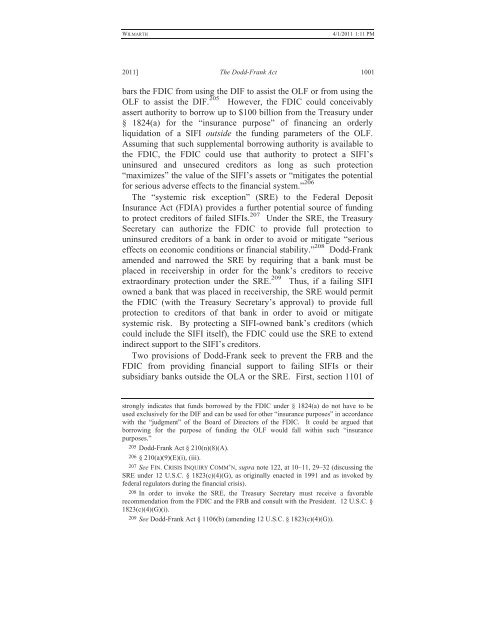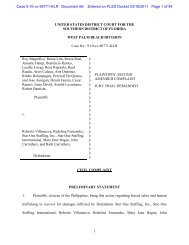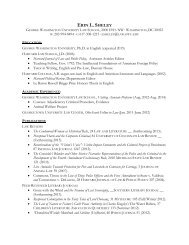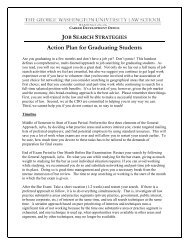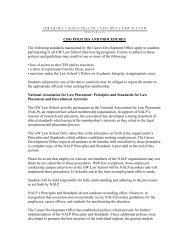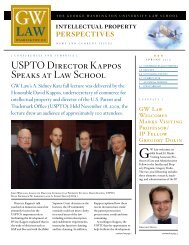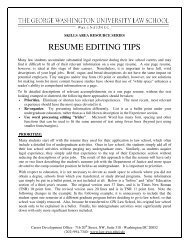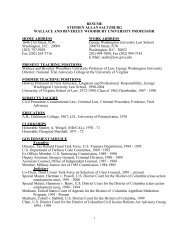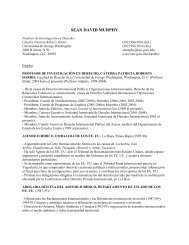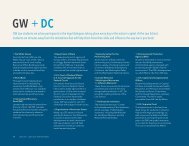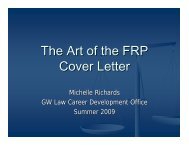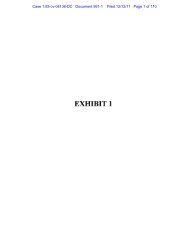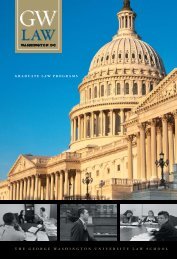CLE Materials for Panel #1 - George Washington University Law ...
CLE Materials for Panel #1 - George Washington University Law ...
CLE Materials for Panel #1 - George Washington University Law ...
You also want an ePaper? Increase the reach of your titles
YUMPU automatically turns print PDFs into web optimized ePapers that Google loves.
WILMARTH<br />
4/1/2011 1:11 PM<br />
2011] The Dodd-Frank Act 1001<br />
bars the FDIC from using the DIF to assist the OLF or from using the<br />
OLF to assist the DIF. 205 However, the FDIC could conceivably<br />
assert authority to borrow up to $100 billion from the Treasury under<br />
§ 1824(a) <strong>for</strong> the “insurance purpose” of financing an orderly<br />
liquidation of a SIFI outside the funding parameters of the OLF.<br />
Assuming that such supplemental borrowing authority is available to<br />
the FDIC, the FDIC could use that authority to protect a SIFI’s<br />
uninsured and unsecured creditors as long as such protection<br />
“maximizes” the value of the SIFI’s assets or “mitigates the potential<br />
<strong>for</strong> serious adverse effects to the financial system.” 206<br />
The “systemic risk exception” (SRE) to the Federal Deposit<br />
Insurance Act (FDIA) provides a further potential source of funding<br />
to protect creditors of failed SIFIs. 207 Under the SRE, the Treasury<br />
Secretary can authorize the FDIC to provide full protection to<br />
uninsured creditors of a bank in order to avoid or mitigate “serious<br />
effects on economic conditions or financial stability.” 208 Dodd-Frank<br />
amended and narrowed the SRE by requiring that a bank must be<br />
placed in receivership in order <strong>for</strong> the bank’s creditors to receive<br />
extraordinary protection under the SRE. 209 Thus, if a failing SIFI<br />
owned a bank that was placed in receivership, the SRE would permit<br />
the FDIC (with the Treasury Secretary’s approval) to provide full<br />
protection to creditors of that bank in order to avoid or mitigate<br />
systemic risk. By protecting a SIFI-owned bank’s creditors (which<br />
could include the SIFI itself), the FDIC could use the SRE to extend<br />
indirect support to the SIFI’s creditors.<br />
Two provisions of Dodd-Frank seek to prevent the FRB and the<br />
FDIC from providing financial support to failing SIFIs or their<br />
subsidiary banks outside the OLA or the SRE. First, section 1101 of<br />
strongly indicates that funds borrowed by the FDIC under § 1824(a) do not have to be<br />
used exclusively <strong>for</strong> the DIF and can be used <strong>for</strong> other “insurance purposes” in accordance<br />
with the “judgment” of the Board of Directors of the FDIC. It could be argued that<br />
borrowing <strong>for</strong> the purpose of funding the OLF would fall within such “insurance<br />
purposes.”<br />
205 Dodd-Frank Act § 210(n)(8)(A).<br />
206 § 210(a)(9)(E)(i), (iii).<br />
207 See FIN.CRISIS INQUIRY COMM’N, supra note 122, at 10–11, 29–32 (discussing the<br />
SRE under 12 U.S.C. § 1823(c)(4)(G), as originally enacted in 1991 and as invoked by<br />
federal regulators during the financial crisis).<br />
208 In order to invoke the SRE, the Treasury Secretary must receive a favorable<br />
recommendation from the FDIC and the FRB and consult with the President. 12 U.S.C. §<br />
1823(c)(4)(G)(i).<br />
209 See Dodd-Frank Act § 1106(b) (amending 12 U.S.C. § 1823(c)(4)(G)).


